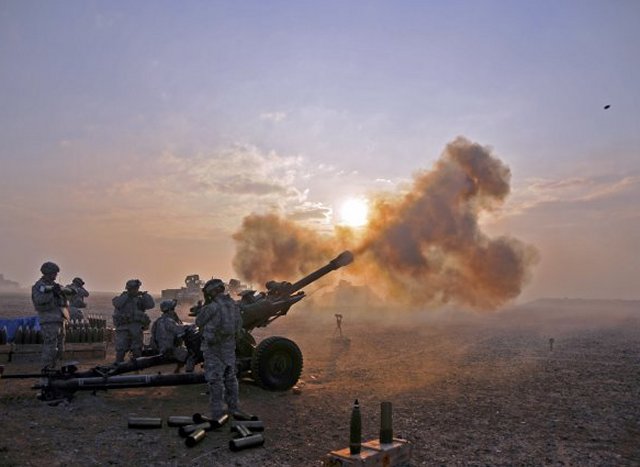Picatinny Arsenal develops safer propelling charge for 105mm artillery cartridges 20311153
| a | |||
|
|
|||
|
Military Defense Industry Technology - Picatinny Arsenal
|
|||
|
|
|||
| Picatinny Arsenal develops safer propelling charge for 105mm artillery cartridges | |||
|
Engineers at the US Picatinny Arsenal are developing a new propelling charge for the family of 105mm artillery cartridges that are safer for the warfighter by eliminating the use of lead and other toxic substances present in the current charge, Picatinny Arsenal unveiled on Oct. 31, 2015.
|
|||
|
|
|||
 Soldiers from Alpha Battery, 2nd Battalion, 320th Field Artillery Regiment, 1st Brigade Combat Team, 101st Airborne Division, fire rounds from their M119A2 howitzer at enemy targets during Operation Fulton Harvest Soldiers from Alpha Battery, 2nd Battalion, 320th Field Artillery Regiment, 1st Brigade Combat Team, 101st Airborne Division, fire rounds from their M119A2 howitzer at enemy targets during Operation Fulton Harvest(Credit: US Army) |
|||
|
|
|||
|
The current propelling charge, called M67, contains seven bags to achieve desired range.
The charge uses a thin lead foil sheet sewn into the zone 5 bag to chemically remove copper that is deposited on the gun tube when a round is fired. The lead is toxic, and the warfighter is exposed to it in the form of lead foil protruding and flaking from the bags before firing, along with exposure to lead liquid and particulates in the air after the propelling charge is fired. When a round is fired, copper from the rotating band on the projectile is deposited on the inside of the gun tube. If the copper is not removed, it will begin to affect performance of subsequent rounds, such as decreased muzzle velocity and range. For the project team, the technical challenge was finding a clean and safe chemical solution to deal with the copper in the tube. The solution turned out to be to replace lead with non-toxic Bismuth, which has been demonstrated to be effective in the 155mm Modular Artillery Charge System (MACS) since 2002 and works even better than the toxic lead, according to findings by the research project team. Along with the change in de-coppering agent, environmentally friendly ingredients are being used to replace several of the legacy plasticizers and stabilizers in the current M1 propellant. The standard M67 is the current propelling charge is capable of being fired from M119-series howitzer by the U.S. Army, as well as the AC-130 Gunship by the U.S. Air Force. It is also used in several 105mm cartridges including high-explosive, illumination and smoke. All of these items will benefit when the switch is made to the newer, environmentally friendly propellant. “Our goal is to eliminate lead from the manufacturing process completely by 2017,” said Paul Henderson, the project lead at the Armament Research, Development and Engineering Center at Picatinny Arsenal. The proposed change in propellant charge for 105mm programs is intended to be transparent to the end user. That means: no impact on logistics, no impact on operation effectiveness, no re-training necessary. The new propellant containing Bismuth is called PAP7993-mod, whereas PAP stands for “Picatinny Arsenal Propellant.” The original PAP7993 was the Army’s first environmentally green propellant formulation that was type-classified in 1999 for use in 155mm MACS, which has produced and fielded more than 19 million pounds to date. “With minor modifications, PAP7993-mod is a viable, low-risk, drop-in replacement to the M1 propellant in the M67 propelling charge, and will eliminate the use of more than 1,000 pounds of lead per year currently used in 105mm ammo,” Henderson said. The new propellant is currently being qualified and will be implemented through an Engineering Change Proposal to the current Technical Data Package in FY16, and transitioned into M67 propelling charge production in FY17. The effort has two funding sources: the Project Manager Combat Ammunition Systems, or PM-CAS, and the Environmental Security Technology Certification Program, or ESTCP, which is the Department of Defense environmental technology demonstration and validation program. The project team also includes BAE Systems, Inc. |
|||


























